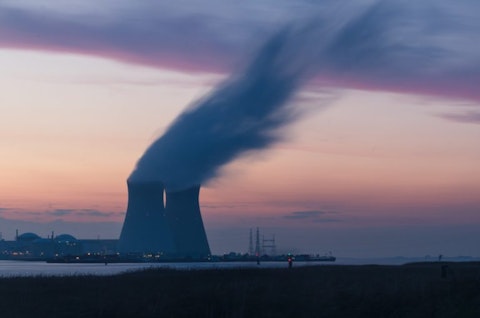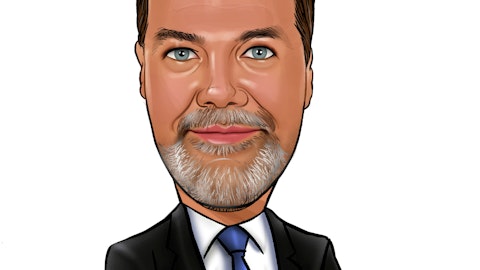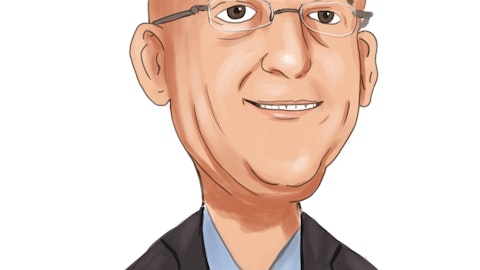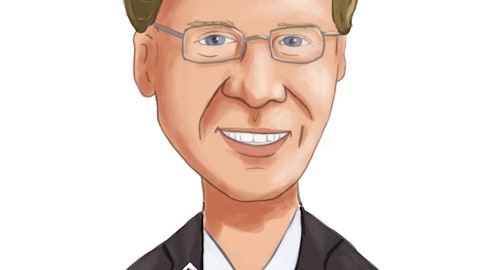TETRA Technologies, Inc. (NYSE:TTI) Q4 2022 Earnings Call Transcript February 28, 2023
Operator: Good morning, and welcome to TETRA Technologies Fourth Quarter 2022 Results Conference Call. The speakers for today’s call are Brady Murphy, Chief Executive Officer; and Elijio Serrano, Chief Financial Officer. Please note this event is being recorded. I would now like to turn the conference over to Mr. Serrano. Please go ahead sir.
Elijio Serrano: Thank you, .Good morning, and thank you for joining TETRA’s Fourth Quarter 2022 Results Call. I would like to remind you that this conference call may contain statements that are or may be deemed to be forward-looking. These statements are based on certain assumptions and analysis made by TETRA and are based on several factors. These statements are subject to several risks and uncertainties, many of which are beyond the control of the company. You are cautioned that such statements are not guarantees of future performance and that actual results may differ materially from those projected in the forward-looking statements. In addition, in the course of the call, we may refer to EBITDA, adjusted EBITDA, adjusted EBITDA gross margins, free cash flow, net debt, net leverage ratio, liquidity or other non-GAAP financial measures.
Please refer to yesterday’s press release or to our public website for reconciliations of non-GAAP financial measures to the nearest GAAP measures. These reconciliations are not a substitute for financial information prepared in accordance with GAAP and as should be considered within the context of our complete financial results for the period. In addition to our press release announcement that went out yesterday, we encourage you to refer to our 10-K that will be filed yesterday. Brady I will turn it over to you.
Brady Murphy: Thanks, Elijio, and good morning, everyone. Welcome to TETRA’s fourth quarter 2022 earnings call. I’ll summarize some highlights for the fourth quarter, comment on the current outlook as well as provided an update on our strategic initiatives before turning it back to Elijio to discuss cash flow, working capital and the balance sheet, liquidity and add some color to the SK 1300 section 19 economic analysis that we issued last night. We closed out a strong year in 2022 with a strong fourth quarter growing revenue sequentially 9% over the third quarter and 42% for the full year over 2021. Adjusted EBITDA of $20.3 million increased from $18.6 million in the third quarter and for the full year excluding market-to-market gains in 2021.
Our adjusted EBITDA for 2022 more than doubled, increasing by 112% over 2021 with almost a 30% follow through on incremental EBITDA to incremental revenue. Despite some headwinds during the fourth quarter, that we mentioned that our last quarterly call, including the postponement of pure flow orders, and the need to purchase additional bromine at spot market prices, we more than overcame these challenges by capturing multiple high margin completion fluid sales in an increasingly and strengthening offshore market. For the combined markets of the Gulf of Mexico and our international offshore businesses we increase quarterly sequential revenue by 20% and more than 50% year-on-year. The completion of our first UK Neptune job along with continued improvements to the disrupted supply chain for our European chemicals business contributed to our successful Q4 results were scheduled for another North Sea Neptune job in the second quarter this time in Norway.
We continue to believe we’re entering a multiyear growth cycle for the offshore markets and the increases in floater day rates, contract durations and subsea tree orders are underpinnings for that belief. As a result of the offshore deepwater market concentration over the past eight years certain oilfield services segments are already in a tight supply situation. This is why I say that energy services is projecting a 25% increase in deepwater floater rigs by 2025. In the fourth quarter, we took steps to further strengthen and expand our offshore completion fluids business with two key investments with the acquisition of the North Sea completion fluids business and acquiring New Parks Completion Fluids inventory and deepwater base in Port Bucha and Louisiana, servicing the Gulf of Mexico.
These investments will increase TETRA’s fluid capacity by 70% in the UK sector of the North Sea and by almost 15% in deepwater Gulf of Mexico operations. Both operations contributed financially upon close, and approximately 40% of the acquired new park inventory has already been sold. The segment results for completion fluids and products fourth quarter of 2022 revenue of $66 million increase from the third quarter of 2022 by 12%. Adjusted EBITDA of $16 million increased $1.3 million sequentially, while just the EBITDA margins improved by 40 basis points sequentially when excluding on realized gains and losses from both periods. Shifting to our Water and Flowback segment revenues of $81 million grew 52% year-on-year and 7% quarter-on-quarter, and a flat the slightly down active frac fleet market in the fourth quarter, somewhat due to year end weather.
This marks the seventh consecutive quarter of sequential revenue increases and the highest quarterly revenue since the second quarter of 2018. Adjusted EBITDA of $12.1 million improved by $5.2 million or 75% year-on-year. Although adjusted fourth quarter EBITDA margins of 14.9% fell slightly from Q3 mainly due to a mix of lower margin services. For the full year Water and Flowback revenue for 2022 grew by 66% and adjusted EBITDA increased by 191% for a fall through a slightly over 25%. We achieved our target set for 2020 to a 15% adjusted EBITDA margin, with adjusted EBITDA of $43.4 million or 15.5% of revenue. Growth was driven by capital investments made in technology to expand our fleet of TETRA sandstorms through international expansion from the deployment of the early production facilities in Argentina and leveraging our investments in automation by reducing operations personnel at the job site.
We expect adjusted EBITDA margins to rebound in the first quarter and beyond for the full year of 2023. International contribution is also expected to increase in 2023 as we bring online an additional EPF in Argentina in the second quarter. To-date, the two operating EPS have been operating consistent with expectations. For 2023 we will continue to optimistically invest in new capital projects with short term returns. But our focus will be on EBITDA margin expansion and cash generation unless all new growth as we’ve achieved over the last couple of years. As previously announced in December, we’re very pleased with the results of our first field pilot project for desalination of produced water for beneficial reuse in Texas for a major oil and gas operator.
The results yielded as high as 92% desalinated water from the reduced water with total dissolved solids below that of the average municipal tap water. The equipment has returned to our R&D facility and is undergoing further enhancements for a final commercial plant design. With the recent and increasingly seismicity events in the Permian Basin, along with expected increase in produced water and disposal restrictions, we continue to see significant customer interest in produced water beneficial reuse, including mineral extraction. Finally, in the fourth quarter, we continued to advance our strategic initiatives including the technical and financial analysis for the development of our bromine and lithium brine resources in the smackover formation in southwest Arkansas.
We issued a press release yesterday announcing the progress on our bromine project with an SK-1300 section 19 report available now on our website for review. A few key points regarding this potential project that supports our continued efforts to fully evaluate this resource development. Our current long term bromine supply agreement has plenty of runway. So we will be very methodical about our evaluation and investment decision. As a reminder, the inferred resource report provides estimates for both bromine and lithium within our targeted 5000 acres. And although our SK-1300 section 19 report focuses on bromine, 35% of the estimated project CapEx in our section 19 report would be for wells and pipelines for brine production that would have both bromine and lithium in the brine.
The proposed bromine plant as part of the Hardgrove feed study would initially support 45% to 50% more volume than our current long term supply agreement. However, the bromine tower itself is designed to accommodate up to 150% of our current supply agreements. If the multiple conditions that are laid out in our press release from yesterday are met that would support us moving forward on this project we could meet our projected oil and gas demand for this upcoming offshore cycle, as well as what we believe to be a conservative estimate of the energy storage demand. Although methodical in our evaluation, we are committed to putting up the right effort and right resources to fully explore this significant opportunity. Finally progress with our Woodlands Texas R&D center continues on lithium extraction technology as we’re establishing pilot units to address each stage of the process.
Starting with our raw smackover brine from our well in Arkansas to success simply producing a lithium carbonate, which we’ve already demonstrated at lab scale. We will continue to communicate our progress as this work advances. With that, I’ll turn it over to Elijio to provide some additional commentary. Then we’ll open it up for some questions.
Elijio Serrano: Thank you Brady. Cash from operating activities was the use of $7 million in the fourth quarter while adjusted free cash flow from continuing operations with the use of $14 million in the quarter. Accounts receivable increased by $24 million from the end of the third quarter to the end of the fourth quarter, reflecting the strong ramp up in activity by the end of the quarter, driven by some large fluid sales in December that Brady previously mentioned. Working capital at the end of the year with $101 million and compares to $87.5 million at the end of the third quarter. Working capital consumed $18.8 billion of cash in the fourth quarter as compared to a use of cash of $8.6 million in the third quarter. Capital expenditures were $7.2 million and compared to $12 million in the third quarter.
Total year capital expenditures were $38 million and reflect the investments made with quick payback investments such as Sandstorm filtration technology and to strengthen our long term position in international and offshore markets to the investment in early production facilities in Argentina and increase capacity for our short completion fluids business. The payback on this on the sandstorms in the early production facilities was very evident if our quarterly EBITDA margins increase materially in the second half of the year, compared to the first half of 2022. In 2023, we expect to achieve strong revenue growth on lower CapEx investments while monetized much of the accounts receivable that was built at the end of the year. These combinations will result in significant free cash flow generation in 2023.
Capital expenditures in 2023 is expected to be below where we expended in 2022. At the end of the fourth quarter, unrestricted cash was $14 million and availability under our credit agreements was $72 million. As of yesterday, liquidity had improved by the end of the year by $10 million to $95 million with no borrowings under our existing asset based lending facility. Long term debt with a September 2025 maturity is $156 million, while net debt is $143 million. Net debt net leverage ratio was 1.99 times at the end of the fourth quarter. Outstanding borrowers under our term loan have been reduced by over $57 million from $220 million September 30, 2020 to $163 million as of September 31, 2022. In addition to the liquidity and cash I mentioned earlier, we are holding some significant marketable securities.
We’re currently holding 400,000 shares of standard lithium, with a market value of approximately $1.7 million based on yesterday’s closing price. We do not have any restrictions on selling the shares. We expect to receive another 400,000 shares in May. We are also holding approximately 5.1 million common units of CSI compressed code, with a market value of approximately $7 million based on yesterday’s closing price. We also don’t have any restrictions from selling this common units. And our investment in CarbonFree is currently valued at approximately $6 million. This one is not publicly traded. The total of these investments is slightly less than $15 million. Recall that in late 2021 we sold the 1.6 million shares that we had accumulated in standard lithium is slightly under $11 per share, generating almost $18 million of cash proceeds.
Also as a reminder, we accumulated approximately $411 million of tax loss carryforwards in the United States that can offset future taxable income. In addition to the $411 million of federal net operating loss carryforwards we also have significant state income tax loss carryforwards and some international tax loss carryforwards. This will become very important as we continue to improve our profitability allowing a higher conversion of net income to cash flow. In 2022, we generated over $11 million of pre-tax income and paid income taxes overseas but no U.S. income taxes. These tax loss carry forwards will also be valuable to us as we look for profits from our Arkansas bromine and lithium investments in the future. I like now to spend a few minutes on the other press release that we issued last night.
Brady mentioned that some of the work that we have been focused upon using a significant amount of internal and external resources have been accomplished. We are taking a very methodical and measure process to assess our Arkansas assets. I want to be sure that our investor base fully understands this process is there are no imminent significant investments to be made. We’ll aim to be very transparent as we go through various gates. We previously announced that we had completed an inferred resource study. We estimated the potential amount of bromine and list them on our list acreage. And inferred resource is one that is based on limited sampling, and is based on reasonably assume but limited information. Sample might include data that is publicly available.
Previous geological maps and well data from the surrounding area allow for reasonable assumptions about the size and scope of this resource. We drilled a test well in 2022, that allowed us to capture incremental data points, other than to make some expenditures to further assess this assets, we would not make any significant investment decisions simply on the basis of an inferred resource study. One step up from an inferred resource is an indicator resource study or the quantity, grade and quality, shape, size and contiguity can be more confidently reported. We are drilling a second well to get to this stage. Then the next step is a major resource which represents the highest level of geological knowledge and competence in a resource. At this stage, the resource characteristics are well established to detailed and reliable exploration work.
Economic and technical factors can be more competently applied. Mining and production planning can give more detailed estimate of economic viability. The economic analysis we published on our website yesterday is from the inferred resource analysis, from the reservoir modeling that we have done, and from a front end engineering device study we did with a third party engineering firm. The economics are preliminary and there is no certainty that the economics contained in the report will be realized. However, the outcome was such that it gives us confidence to invest approximately $5 million to get to the next stage, inclusive of the second test well and further economic assessments. Note that the stages that I just mentioned all arrive at an estimated resource, each with a greater degree of confidence, and each with incremental data points.
To move from resources to reserves additional work is required beyond proving the quantities of minerals available to us. To move from resources to reserves, we now need to do further engineering economic assessment to demonstrate that we can take this resources and commercialize them successfully. Inferred mineral resources are considered to have the lowest level of geological competence of all mineral resources. Inferred mineral resources have a high degree of uncertainty as their existence and to whether they can be economically or legally commercialized. A significant amount of exploration work must be completed in order to determine whether inferred resource mineral can be upgraded to a higher category. The difference between a resource and a reserve comes down to a feasibility study, which takes into account non-geological factors.
These include technical factors, which include extracting the brine and processing the bromine. This also includes additional economic planning, such as detail engineering design, and environmental information analysis. Our reserve is the finest pop-up in economic extraction can be justified. Our reserve is defined as proven when economic extraction is justified. Our next step is to gather incremental data points to move from inferred to indicated and to complete a feasibility study. This will take several months. From here we can have more confidence that we can successfully from an economic point of view, proceed with an investment in wells, pipelines and a processing plant. The fact that Lanxess and Albemarle are doing exactly what we are evaluating gives us confidence that we are likely to have a successful project if and when we make a decision to move forward.
And as a reminder, the process and then what knowledge has been in practice for many years, and no new technologies or processes need to be developed to accomplish what we’re after. The field study we completed with the engineering firm estimated that the cost of the wealth resource of brine, inject a leftover or the tail brine build the pipelines and construct the brine to bromine processing facility could be approximately $280 million inclusive of $35 million of contingencies and inclusive of about an estimated $20 million of work to allow us to upsize the facility in the future for potential higher volumes of bromine processing. And as Brady mentioned earlier, the $99 million identified for wells and pipelines. We extract and move the brine can also be used for lithium in the future.
Thus $280 million entailed an investment that includes what we believe to be significant contingencies. Investments lay the groundwork to increase production in the future, and as well as in pipelines that can leverage future lithium production. The bromine plan as we mentioned in our press release has a multipurpose focus. The first step to increase the amount of cost effective bromine available to TETRA above the volumes currently available to us from our long term agreement to address an expected multiyear growth in the offshore oil and gas market assuming commodity prices remain relatively constant. TETRA is already experiencing an increase in demand that exceeds volume available under long term supply agreement. The second is to address emerging demand for zinc bromide based battery storage, which may be significant TETRA pure for customers are successful in ramping up their operations.
The third is to reduce TETRA’s dependence on open market purchase third party purchases of bromine by producing bromine and potentially materially lower production costs. And the fourth and final objective will be to control our own supply chain for the longer term and beyond the life of our current multiyear agreement, we still have several years to go. We also mentioned that we have engaged in investment banking firm to help us identify potential strategic partners should we make the decision to potentially proceed after completing an indicated resource study with a feasibility study to move from resources to reserves. At this point, we have not made a decision to proceed with this investment. The economics based on preliminary work look attractive for us only to move to the next phase of analysis and to reach out to identify potential partners.
The decision to partner with someone will be based on whether we identify potential partners with the structure we believe it’s appropriate for TETRA in our investors. Given the size of the investment required and realizing we will not put too much leverage on TETRA’s balance sheet. We believe identifying potential strategic partners will be the best path forward. We are also in preliminary discussions with the Department of Energy discussing opportunities for loans and grants for our bromine project. The final item I like to add is that we’ll be participating at the Scotia Howard Weil Conference next Tuesday, hosting one on ones and making a presentation Tuesday afternoon that will be webcast. If you’d like to participate, please reach out to me or Brady.
Again, I encourage everyone to read our news release that we issued yesterday. The bromine project report we posted to our website and the 10-k that we filed yesterday for all the supporting details and additional financial and operational metrics. Please call me if you would like to discuss any of these items further. I will turn it back over to Brady for closing comments.
Brady Murphy: Thank you, Elijio. To recap 2022 Not only did our base business perform very well, but we’ve also made significant investments in our business to expand our earnings base in the coming years. Over the last several quarters, we’ve nearly doubled our fleet of TETRA Sandstorm advanced cyclone technology which remained at a very high utilization. We’ve also invested in international markets the deployment of EPS as well as our completion of fluids business expansion. And we have invested to boost our capacity in the Gulf of Mexico to support increasing deepwater activity. While increased offshore activities already contributing very meaningful to our earnings. Significant upside remains with deepwater projects due CS Neptune offering.
As Elijio mentioned, we expect to achieve strong growth and ’23 over 2022. That coupled with our focus on margin expansion and cash generation to drive meaningful cash flow generation in 2023. We’re excited and committed to fully evaluating the Arkansas brine resource, and we’ll continue to communicate updates as appropriate. With that, we’ll open up to questions.
See also 12 NASDAQ Penny Stocks Under 10 Cents and 17 Biggest MLM Companies in the World.
Q&A Session
Follow Tetra Technologies Inc (NYSE:TTI)
Follow Tetra Technologies Inc (NYSE:TTI)
Operator: Thank you. We will now begin the question and answer session. Our first question comes from Martin Malloy with Johnson Rice. Please go ahead.
Martin Malloy: Good morning.
Brady Murphy: Good morning.
Martin Malloy: Good morning. I want to ask good morning. I want to ask about the offshore completion fluids market and certainly seems like there’s a inflection point here and activity going on. Could you maybe talk about the pipeline and the visibility as you talk with customers and maybe in particular on the Neptune product?
Brady Murphy: Yes. Martin So as we mentioned, we covered our first UK Neptune job. We’ve previously performed Neptune job both in the Gulf of Mexico and in Norway. We have another Norway project that we plan to be executing in the second quarter. And really, our objective has been to get more repetitive projects in our business, as opposed to the lumpiness that we’ve seen in the past, and I think we’re getting some traction with that, certainly in the North Sea. And I think we expect to have more repetitive jobs in the North Sea business. The Gulf of Mexico, obviously, these are much larger projects, those four pipelines, where we’re very engaged with our customers on those projects. We may see some projects come forward in before the end of this year. But it’s more likely that we won’t see a meaningful uptick in our Neptune opportunities until we get into the ’24 and beyond.
Martin Malloy: Great, thank you. And my second question, want to ask about your flow. And your ability to ramp up assuming that your customers are able to increase capacity and throughput and get the government funding that they’re looking for. Can you maybe talk about your ability to ramp pure flow and any additional CapEx would be required?
Brady Murphy: Yes. Our ability to ramp up production of PureFlow through our West Memphis facility we need very little to no capital at our West Memphis production facility. We have plenty of capacity at that plant. The issue really for longer term is the ramp up and energy storage, if our customers are successful, as you noted in ramping up the demand levels were pretty dramatically exceed our current supply agreement for bromine, which is one of the reasons why we’re looking so carefully at our Arkansas project and the timing of that Arkansas project as it relates to the success, potential success of our Pureflow customers because if they are successful based on the demand opportunities that are there, it will have a meaningful impact to the bromine market.
Martin Malloy: Great, thank you. I’ll turn it back.
Operator: The next question comes from Stephen Gengaro with Stifel. Please go ahead.
Stephen Gengaro: Thanks. Good morning, everybody. Morning. Two things for me. And pardon if you hear background noise because I’m in a lobby of a hotel. So I’m sorry about that. When we think about the quarter was obviously very good on the top line. And I was as I started to think about the progression going forward. Was there anything in the quarter that I should be kind of contemplating as I think about sequential performance in the first quarter of 2023? And maybe in addition to that, how should we think about the water and flowback business if we given sort of a plateauing in North American activity right now?
Brady Murphy: Yes. Yes Steven I will cover the water flow back first. I’d mentioned we’ve had significant growth in this business for us, quite frankly, the pace of growth that we achieved in 2022 well exceeded the market. And when you grow like that, you typically take on some costs, and it’s difficult to be as efficient as you would like to be with your business. And that caught up a little bit with us in the fourth quarter, some of it was a mix issue where we dropped slightly on our margins, but we fully see a rebound to back to increasing margins as we go forward in Q1 and beyond for the full year. I think from a margin expectation, we would build on the second half of the margins for our water and flow business, the activity that you saw.






